This site is supported by our readers. We may earn a commission, at no cost to you, if you purchase through links.
 Birds are as fascinating as they are diverse, with over 9,500 species spread across the globe.
Birds are as fascinating as they are diverse, with over 9,500 species spread across the globe.
Did you know some birds, like hummingbirds, can fly backwards? Or that the Peregrine Falcon is akin to a sports car, reaching up to 242 mph when diving for prey?
Birds communicate through calls and whistles, forming complex social groups that rely on their unique "911 system" to convey information about danger, hunger, or location, as revealed in the intricacies of bird calls and their functions. Birds communicate through calls and whistles, forming complex social groups sometimes rivaling a soap opera.
If you’re birdwatching, grab some binoculars and welcome them to your backyard with bird feeders.
It’s a world full of life and color out there, and with a bit of patience, you’ll uncover even more amazing bird facts for beginners.
Table Of Contents
- Key Takeaways
- Getting Started With Birding
- Bird Anatomy and Behavior Basics
- Bird Diversity and Distribution Explained
- Amazing Bird Flight and Migration Facts
- Bird Reproduction and Nesting Habits
- Bird Diet and Nutrition Basics
- Bird Conservation and Threats to Their Populations
- Fun Facts and Trivia About Birds
- Frequently Asked Questions (FAQs)
- How can I learn about birding?
- How do I start birding?
- What are the most extraordinary facts about birds?
- What do you know about birds?
- What is a fun fact about birds?
- What are some rare facts about birds?
- What do birds eat facts for kids?
- How to explain birds to kids?
- What are the rarest bird species today?
- How do birds communicate with each other?
- What is the oldest bird fossil found?
- How do birds keep warm in winter?
- What are the smartest bird species?
- Conclusion
Key Takeaways
- You’ll discover that birds communicate through fascinating calls and whistles, not just for emergencies but to form social connections and attract mates.
- Birdwatching starts simply with a pair of binoculars and can be enriched by connecting with local birders for insights on locations and equipment.
- Birds have some amazing flight adaptations; for example, Peregrine Falcons can dive at speeds of 242 mph, showcasing nature’s incredible engineering.
- Birds face threats from human activities like habitat loss and climate change, but conservation efforts can help protect these vibrant species.
Getting Started With Birding
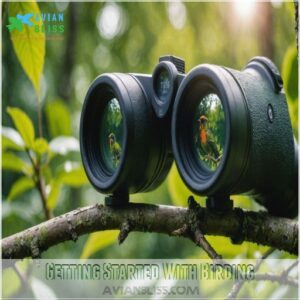
Grab a pair of binoculars for a closer look, and don’t forget to chat with local birders who can share tips and tricks to enhance your adventure.
Step Outside and Explore Nature
Imagine stepping onto a nature trail, binoculars in hand, ready to begin your birding adventure.
Enjoy observing local wildlife and capturing moments with nature photography.
Listen closely for bird songs as you refine your bird identification skills.
Birdwatching tips? Start with bird feeders to attract a variety of species, and don’t forget those handy birding apps .
To attract a variety of species, consider installing bird feeders from a reliable online store like this bird feeder supplier.
Invest in Binoculars for Better Views
So, you’ve explored nature; now, let’s enhance your view!
Good birdwatching binoculars are your best friend.
Consider 8×42 binoculars for a great balance of magnification and brightness.
For beginners, essential tools like binoculars and a bird identification guide can greatly enhance the birding experience. Don’t forget a field guide—a bird guide or even a helpful bird app will aid identification.
Choosing the right birdwatching binoculars can make all the difference.
Happy birding!
Seek Out Different Locations for Birding
Venturing beyond your backyard can transform your bird watching experience.
Explore urban birding in city parks, or seek coastal habitats where unique species thrive.
National parks and bird sanctuaries offer a treasure trove of bird sightings.
With a trusty field guide, head out on birding tours to discover diverse bird habitats—each location a new chapter of your adventure (Source).
Connect With Local Birders for Tips
When starting your birding adventure, connecting with local birders offers invaluable insights.
You’ll gain access to:
- Local bird guides for species identification.
- Tips on the best birding spots in your area.
- Recommendations on essential birding equipment.
- Access to bird clubs for community and learning.
These connections provide bird advice and heighten your birding experience.
Bird Anatomy and Behavior Basics
As you begin your birding adventure, you’ll be amazed by the fascinating physical features and quirky behaviors of birds, like how owls move their heads to see behind them.
Understanding these basics will enhance your appreciation and also make every bird-watching experience more exciting and rewarding.
Unique Physical Features of Birds
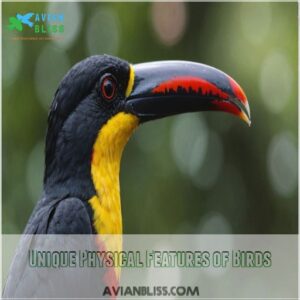
From sharp bird beaks perfect for snapping up food, to bird feet for perching and scrabbling, each part plays a role.
Some birds even have long legs, like those found in birds with long legs, which allow them to wade in shallow waters and navigate unstable environments.
Marvel at the colorful bird feathers designed for flight and warmth, while bird wings and agile bird eyes add to the spectacle.
Grab your bird book and start a feathered adventure!
How Birds Move and Fly
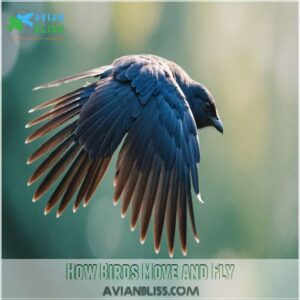
Wings vary from graceful soaring in eagles to rapid flapping in sparrows.
Here’s how it works:
- Wing Types: Elliptical, soaring, and high-speed wings suit different lifestyles.
- Feather Functions: Provide lift and control.
- Flight Styles: Soaring requires fewer flaps; migration involves precise energy use.
So, grab binoculars and witness their amazing journeys!
Bird Communication and Social Behavior
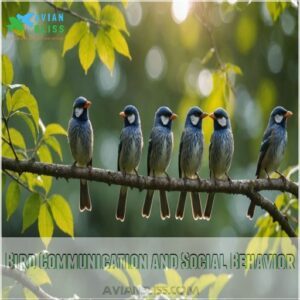
Birds use calls and whistles not just to sound alarms but also to maintain flocks and woo potential mates.
Their social structures and territorial spats mirror a neighborhood drama—just feathered.
Here’s a glimpse:
| Behavior | Purpose | Example |
|---|---|---|
| Bird Calls | Communication | Gray Catbird |
| Flocking Behavior | Safety in numbers | Starlings |
| Mating Rituals | Mate attraction | Bowerbirds |
Bird Diversity and Distribution Explained

Types of Bird Species and Their Habitats
Imagine birds using their unique anatomy to thrive in diverse habitats.
You’ll find species like the Harpy Eagle in lush tropical forests or the elegant Greater Roadrunner zipping through arid deserts.
Consider these habitats:
- Forests: Dense, tree-filled homes.
- Deserts: Sparse, dry expanses.
- Wetlands: Marshy retreats.
- Grasslands: Open, grassy areas.
Each offers unique challenges and adaptations.
Regions With The Highest Bird Diversity
When exploring the world, you’ll find the most bird species in regions like the Amazon and the Andes, known for their incredible bird diversity and endemism.
To maximize your chances of spotting rare birds, follow a reliable birdwatching guide, such as those that emphasize the importance of using binoculars for bringing distant birds up close Understanding Binoculars.
Tropical rainforests ignite dreams of adventure while raising conservation challenges, eco-tourism impacts, and climate change concerns.
| Region | Bird Diversity | Conservation Challenges |
|---|---|---|
| Amazon | High | Yes |
| Andes | Very High | Yes |
| Eurasia | Moderate | Varies |
Birds aren’t just feathers; they’re global stars!
Most Common and Rare Bird Species
The humble domestic chicken tops the list as the most abundant bird, with a staggering 22.67 billion worldwide, reflecting its culinary and cultural prominence.
Your birding can support conservation efforts by highlighting habitat impacts, such as the loss of natural habitats for species like the burrowing owl, who often repurpose abandoned prairie dog burrows. Your birding can support conservation efforts by highlighting habitat impacts and monitoring population trends.
In contrast, the critically endangered Spix’s macaw emphasizes the extinction risk faced by rare species.
Amazing Bird Flight and Migration Facts
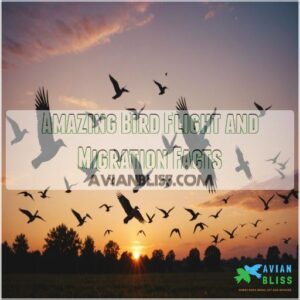
The Arctic tern’s remarkable journey spans an incredible 25,000 miles annually, traveling from the Arctic to Antarctica, showcasing its Arctic tern migration. Get ready to be amazed by feats like the Arctic tern’s epic migration journey and the Peregrine Falcon’s lightning-fast dives!
Birds With Unique Flight Capabilities
You’re exploring bird diversity and stumble upon fascinating flight capabilities, but did you know that birds evolved to lose their teeth, which is discussed in-depth in birds and their beaks.
Hummingbird flight mesmerizes with rapid wingbeats, hovering like a tiny helicopter—a skill unmatched in the avian world.
Meanwhile, birds of prey, like kestrels, showcase impressive hovering skills as they hunt for prey with pinpoint accuracy.
Celebrate these unique adaptations, adding a dash of wonder to your bird-watching adventure!
Longest Annual Migration of Any Bird
Imagine setting out on a cross-global adventure like the Arctic Tern Migration—an epic journey stretched over 44,000 miles annually!
This little bird navigates vast oceans and climates with impressive Navigational Strategies, dodging Migration Risks like storms and predators.
To Fuel the Flight, terns pause in the Atlantic, snacking on fish and crustaceans, making their marathon migration a true natural wonder.
Fastest Flying Birds in The World
So, those amazing migrations!
Now, let’s talk speed.
Prepare to be amazed by the fastest fliers.
The Peregrine Falcon reigns supreme, reaching incredible diving speeds of 242 mph!
Its adaptations, like streamlined bodies and pointed wings, are key to its success, making it an apex animal predator.
Check out these other speed demons:
- Saker Falcon
- Grey-headed Albatross
- Common Swift
Their impressive flight mechanics are a clear example of evolution.
Bird Reproduction and Nesting Habits

You’ll find that their parenting skills are equally intriguing, as large bird species often take longer to hatch, ensuring their chicks are ready to take on the world.
Mating and Breeding Habits of Birds
Many bird species showcase enchanting courtship rituals.
Males woo females with striking displays, like the lyrebird’s plumage dance.
Nest building techniques vary; some birds use mud, others prefer twigs.
Egg incubation requires patience, often shared by both parents.
Parental care is essential, especially during hectic breeding seasons.
Remember, not all birds choose the same mate twice!
Nesting and Incubation Processes
Encompassing nest construction and the incubation period, bird nesting involves intricate processes.
Birds build nests for shelter and egg protection, engaging in parental care that guarantees chick development and nest defense.
Here’s a quick guide to nesting:
- Selection involves finding a safe, hidden spot.
- Construction uses available materials for a stable nest.
- Incubation requires constant warmth and vigilance.
Parenting and Fledgling Care
Bird parents are quite the busybodies! They handle nestling development through constant feeding and keep a watchful eye to defend the nest.
But beware of brood parasitism; some birds sneak their eggs into other nests!
When fledgling independence kicks in, it’s like watching teenagers test their wings. They’re cute chaos. Ready for birding? Observe these fascinating processes at play.
| Aspect | Details |
|---|---|
| Nestling Development | Intensive parental care |
| Parental Feeding | Frequent, varied meals |
| Fledgling Independence | Testing wings, gaining skills |
Bird Diet and Nutrition Basics
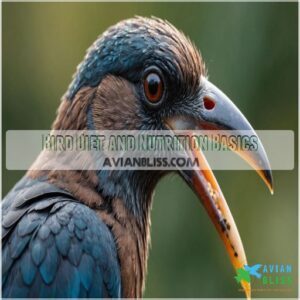
Birds are expert foragers and hunters, utilizing their keen eyes and specialized beaks.
Keeping a fresh water source nearby is essential for their hydration and digestion, much like our morning coffee fix.
Types of Food Birds Eat
After nest-building is done, feast time begins!
Birds have diverse diets with dazzling food preferences.
Explore their menu with these favorites:
- Seed eaters: Watch sparrows gobble sunflower seeds like popcorn.
- Nectar eaters: Admire hummingbirds sipping nectar, their sweet tooth never satisfied.
- Fruit fanatics: Orioles relish oranges as if discovering treasure!
Understanding bird diets enriches your birding adventure.
How Birds Hunt and Forage for Food
So, you’ve learned what birds eat. Now, let’s see how they get it!
Different birds use different hunting strategies.
Some birds are ambush predators, others actively forage.
Check out these examples:
| Bird Type | Hunting Strategy | Foraging Technique |
|---|---|---|
| Hawks | Ambush | Keen eyesight |
| Woodpeckers | Probing | Strong beaks |
| Ducks | Surface-feeding | Dabbling in shallows |
Birds adapt their techniques to food scarcity; a clever survival trick!
Importance of Water in Bird Diets
Ever wonder how essential water is for a bird’s diet? It’s not just any old splash; it’s key!
Birds rely on water for:
- Hydration: Important for cellular functions.
- Digestion: Aids nutrient absorption.
- Temperature Regulation: Prevents overheating.
- Drinking Habits: Vary with species and environment.
Keep their water access easy, like a café, but for birds.
Bird Conservation and Threats to Their Populations
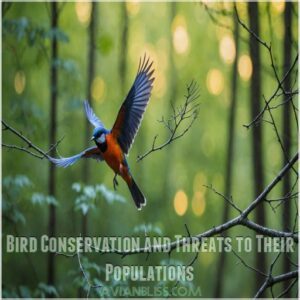
Understanding these challenges is key to helping protect our feathered friends and ensuring they continue to brighten our skies.
Human Activities Threatening Bird Populations
Imagine a world without birds, thanks to habitat loss, climate change, pollution, invasive species, and overhunting, which threaten them daily.
Each act contributes to their decline, but there’s hope.
Your actions can make a difference!
| Threat | Impact | Solution |
|---|---|---|
| Habitat Loss | Displacement | Preserve Areas |
| Climate Change | Species loss | Reduce Emissions |
| Pollution | Health risks | Clean Habitats |
Efforts start with awareness!
Natural Threats to Bird Survival
Birds face several natural threats to their survival, including habitat loss, climate change, disease outbreaks, predation, and natural disasters.
When a bird’s neighborhood turns into a parking lot or when storms strike, their survival hangs by a feather.
Disease outbreaks can also spread rapidly, while predators, like hawks, pose constant challenges to their safety.
Conservation Efforts to Protect Birds
Protecting birds isn’t just for the birds.
You can help by addressing bird habitat loss and climate change impact.
To further reduce bird-related accidents, consider applying window film for bird safety to minimize collisions.
Try these steps:
- Bird-friendly gardening: Plant native species to create safe havens.
- Sustainable farming: Support eco-friendly practices to preserve habitats.
- Citizen science: Join projects that track bird populations, helping experts monitor changes.
Fun Facts and Trivia About Birds

Discover quirky bird behaviors and impressive feats that make these creatures truly extraordinary, offering endless trivia for curious minds.
Record-Breaking Birds and Their Features
Among avian record-holders, you’ll find some real standouts!
Check out these feathered champions:
| Feature | Bird | Detail |
|---|---|---|
| Longest bill | Australian Pelican | Over 18 inches! |
| Biggest eggs | Elephant Bird (extinct) | Size of a grapefruit! |
| Fastest dive | Peregrine Falcon | Over 200 mph! |
These incredible birds showcase nature’s amazing diversity.
Unique Bird Behaviors and Abilities
Building on record-breaking traits, some birds flaunt impressive behaviors and abilities.
Imagine a bird mimicking sounds, using its voice like an impersonator at a nightly comedy club.
Feather structures provide flight adaptations, allowing birds to soar with grace.
From intricate nest building using the silkiest spiderwebs to eloquent bird communication, these creatures master survival’s intricate dance with flair.
Interesting Bird Facts for Beginners
As a budding birder, you might marvel at the Peregrine Falcon’s dizzying 110 mph dive, making it the fastest flying bird (Source).
Explore the vibrant world of birds, where some, like the oilbird, uniquely use echolocation.
Many birds don’t truly hibernate, but rather enter a state of torpor for cold weather, Listen for bird songs, observe bird nests, and ponder bird adaptations as you uncover these winged wonders’ secrets through bird migration and conservation.
Frequently Asked Questions (FAQs)
How can I learn about birding?
You can get started with birding by observing local birds, using handy apps, and grabbing a field guide.
Attend birding events, join online groups, and listen to bird calls to learn more about these fascinating creatures.
How do I start birding?
Grab yourself some binoculars and a field guide or app.
Start noticing birds in your backyard or local parks.
Practice identifying them by color, size, and behavior.
It’s fun, relaxing, and connects you with nature (Source).
What are the most extraordinary facts about birds?
Believe it or not, some birds, like the peregrine falcon, can dive at over 240 mph!
They also have three fingers on each wing and use echolocation, similar to bats.
Isn’t nature amazing?
What do you know about birds?
Birds charm with their vibrant colors, songs, and intriguing behaviors.
Did you know the Sword-billed Hummingbird’s bill is longer than its body?
Birds evolved to lose bladders, too, keeping them light for flight.
What is a fun fact about birds?
Imagine a bird that’s part oil and part bat!
The oilbird navigates in dark caves using echolocation, just like bats.
But don’t worry, it’s not planning a caped crusade any time soon!
What are some rare facts about birds?
Parrots can learn over 800 words, showcasing their intelligence and talent for mimicry. Some bird species, like the thrifty acorn woodpecker, stash up to 50,000 acorns in a single "granary tree" .
What do birds eat facts for kids?
You’re curious about bird diets, and rightly so!
Birds munch on everything from seeds and nuts to insects, fruits, and even small animals.
Imagine them as tiny, feathered gourmets with diverse tastes and fancy feasts!
How to explain birds to kids?
Birds are fascinating creatures with feathers, beaks, and the ability to fly.
They come in all shapes and sizes, from tiny hummingbirds to majestic eagles.
Birds build nests, lay eggs, and often migrate long distances.
What are the rarest bird species today?
Imagine spotting a unicorn in the wild!
That’s what discovering rare birds like the night parrot or Himalayan quail is like.
These elusive species need protection to prevent flying off the radar forever.
How do birds communicate with each other?
They use songs, calls, and alarm calls to communicate.
Body language, like tail flips and wing waving, also plays a big role.
Even some species chat with humans!
It’s a whole avian language!
What is the oldest bird fossil found?
The oldest known bird fossil, Asteriornis maastrichtensis, affectionately called "Wonderchicken," hails from around 7 million years ago.
Found in Europe, it offers valuable insights into modern birds’ evolution just before the mass extinction.
How do birds keep warm in winter?
Birds survive winter as cleverly as you’d layer sweaters, fluffing feathers to trap heat like a cozy blanket.
They eat more to build fat reserves, huddle together, and find shelter in trees or snow tunnels for warmth.
What are the smartest bird species?
Imagine having a bird outsmart you!
Crows, ravens, African Gray Parrots, and New Caledonian Crows lead the brainy bird brigade.
They use tools, remember human faces, and even master problem-solving like feathered Einstein clones.
Conclusion
Surprisingly, for creatures known for winging it, birds offer a structured glimpse into the natural world.
As you get into birding, revel in the quirks and splendor of bird facts for beginners—there’s much to chirp about!
Whether marveling at their aerodynamic feats or understanding their social dynamics, you’re starting a lifelong journey of discovery.
Remember, every feathered friend tells a story, and with patience and curiosity, you’ll uncover nature’s fascinating narratives.
Happy birdwatching!



